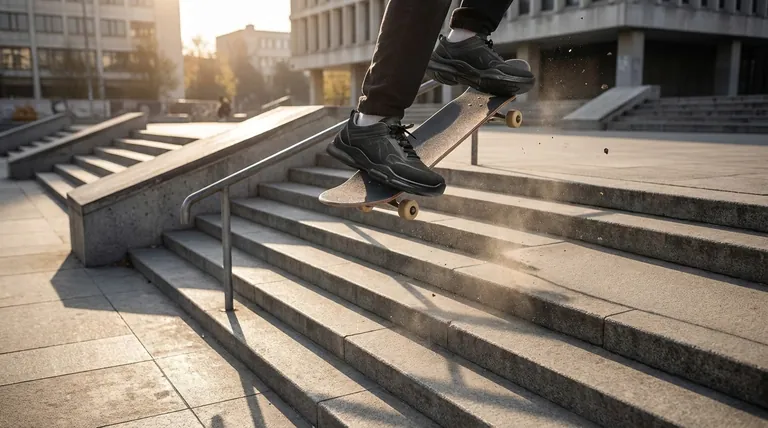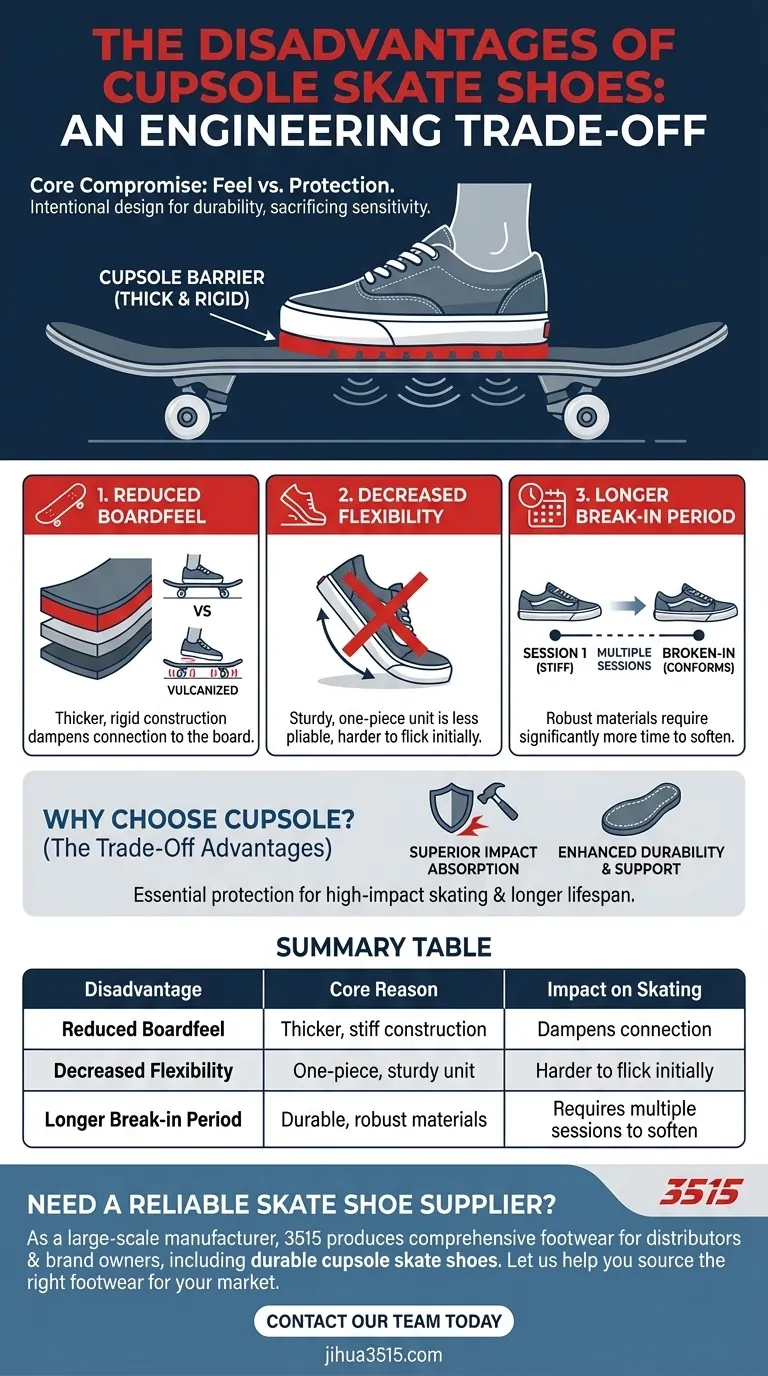At their core, the primary disadvantages of cupsole skate shoes are reduced boardfeel, less flexibility, and a longer break-in period. These traits stem directly from their construction, which prioritizes durability and impact protection over the sensitive connection many skaters desire with their board.
The perceived "disadvantages" of a cupsole are not design flaws, but rather intentional engineering trade-offs. You sacrifice a degree of boardfeel and initial flexibility in exchange for superior foot protection and a longer-lasting shoe.

The Core Compromise: Feel vs. Protection
The fundamental difference between cupsole and vulcanized skate shoes comes down to their sole construction. A cupsole is a pre-molded rubber unit that the shoe's upper is placed into and stitched, creating a sturdier, more supportive final product. This method is the source of both its strengths and its weaknesses.
Reduced Boardfeel
A cupsole's construction is inherently thicker and more rigid than its vulcanized counterpart. This creates more material between your foot and the skateboard.
This added thickness, often including foam midsoles for cushioning, naturally dampens the subtle vibrations and contours of the board, resulting in less boardfeel.
Decreased Flexibility
The one-piece, sturdy nature of the cupsole makes the entire shoe stiffer right out of the box.
This lack of initial pliability can make it harder to flick the board for certain tricks and can feel restrictive until the shoe is thoroughly worn in.
The Extended Break-in Period
Because cupsoles are built with stiffer, more durable materials, they take significantly longer to break in.
Where a vulcanized shoe might feel perfect after a single session, a cupsole often requires multiple sessions for the sole to soften and conform to the shape and movement of your foot.
Understanding the Trade-offs: Why Skaters Still Choose Cupsoles
To fully understand the disadvantages, you must weigh them against the significant advantages that make cupsoles the preferred choice for a large segment of skaters.
Superior Impact Absorption
The very thickness that hinders boardfeel is what provides exceptional impact protection.
Cupsoles are designed to cushion your feet from the harsh landings associated with skating stair sets, gaps, or big rails. This protection can be critical for preventing bruised heels and other foot injuries.
Enhanced Durability and Support
The stitched, one-piece cupsole construction is significantly more durable than the glued-and-baked assembly of a vulcanized shoe.
This robust build offers better overall foot and heel support, which is essential during high-impact maneuvers and contributes to a much longer lifespan for the shoe.
Making the Right Choice for Your Skating Style
Ultimately, the choice is not about which shoe is "better," but which shoe is the right tool for your specific needs.
- If your primary focus is technical ledge or flatground skating: The limited boardfeel and flexibility of a traditional cupsole might hinder your control and performance.
- If your primary focus is high-impact skating (stairs, gaps, rails): The disadvantages of a cupsole are a necessary trade-off for essential foot protection and shoe durability.
- If you seek a balance of both: Consider modern, thinner cupsole models specifically engineered to offer better boardfeel while still providing more support than a vulcanized shoe.
Choosing the right shoe is about aligning its inherent design with the demands of your personal skating style.
Summary Table:
| Disadvantage | Core Reason | Impact on Skating |
|---|---|---|
| Reduced Boardfeel | Thicker, stiffer sole construction | Dampens connection to the board |
| Decreased Flexibility | One-piece, sturdy rubber unit | Harder to flick the board initially |
| Longer Break-in Period | Durable, robust materials | Requires multiple sessions to soften |
Need a reliable skate shoe supplier for your brand or retail business?
As a large-scale manufacturer, 3515 produces a comprehensive range of footwear for distributors, brand owners, and bulk clients. Our production capabilities encompass all types of shoes and boots, including durable cupsole skate shoes built for impact protection and long-lasting performance.
Let us help you source the right footwear for your target market. Contact our team today to discuss your manufacturing needs.
Visual Guide

Related Products
- Wholesale Breathable Training Shoes Custom Athletic Footwear Manufacturer
- Lightweight Breathable Training Shoes for Wholesale & Custom OEM Manufacturing
- Wholesale Breathable & Cushioned Training Shoes Custom Factory Production
- Wholesale Training Shoes with Dial Lacing System Custom OEM Manufacturing
- Wholesale Durable Camouflage Canvas Shoes with High-Traction Cleated Rubber Sole
People Also Ask
- What are the benefits of breathable materials in work shoes? Enhance Comfort & Health for Your Workforce
- What are the benefits of athletic-style work shoes? Boost Comfort and Safety for Your Team
- Why are running shoes and walking shoes not interchangeable? Avoid Injury with the Right Footwear
- What materials are best for athletic activities in warm climates? Stay Cool with Moisture-Wicking Fabrics
- How do athletic shoes with non-slip features differ from regular ones? Discover the Grip Advantage



















